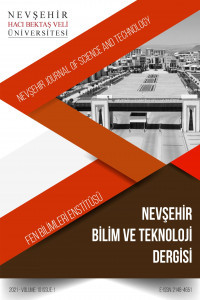Yer Karosu Bünye Reçetesine Cüruf Atığı İlavesinin Fiziksel Özelliklere Etkisinin İncelenmesi
Yer karosu, Demir ve çelik, Cüruf atığı, Gerikazanım
Invesitigation of Effect on Physical Properties by Adding Slag Waste to Floor Tile Body
Floor tile, Iron and steel, Slag waste, Recycling,
___
- [1] Torres P., Fernandes H.R., Agathopoulas S., Tulyaganov D.U., and Ferreira J.M.F., “Incorporation Of Granite Cutting Sludge In Industrial Porcelain Tile Formulations” Journal of European Ceramic Society,24, 3177-3185, 2004
- [2] Joulazadeh M.H., Joulazadeh F.,” Slag; Value Added Steel Industry By Products “Archives of Metallurgy and Materials, 55, 1137-1145, 2010
- [3] Ünal S., Yücel O., Kurt M., Gül S. GÜL, “Atık’tan Ürün’e Demir-Çelik Cürufu”, İleri Teknolojiler Çalıştayı, sy. 255-267, 2014
- [4] Song Q., Guo M.Z., Wang L., and Ling T.C.,” Use of Steel Slag as Sustainable Construction Materialas: A Review of Accelerated Carbonation Treatment” Conservation and Recycling, 173, 105740, 2021
- [5] Baycık S., “Granüle Yüksek Fırın Curuflarının Karo Sektöründe Kullanılabilirliğinin Araştırılması’’ İstanbul Teknik Üniversitesi, Fen Bilimleri Enstitüsü, Yüksek Lisans Tezi, 138s, İstanbul, 2003
- [6] Türkiye Seramik Federasyonu, “Seramik Sektörü Yerli Katma Değer Raporu-8. Dönem Faaliyet Raporu”, sy. 13-25, 2019
- [7] Reed J.S.,” Introduction to The Principles of Ceramic Prosessing” JohnWiley & Sons., 1998
- [8] Yi H., Xu G., Cheng H., Wang J., Wan Y., and Chen H., “An Overview of utilization of steel slag” Procedia Environ Sci., 16, 791-801, 2012
- [9] Kaya G., Turan S., “ Yüksek Fırın Cüruflarının Seramik Sektöründe Katma Değeri Yüksek Ürünlerin Eldesinde Değerlendirilmesi” Mühendis ve Makine, 45, 536, 48-60, 2003
- [10] Teo P.T., et al., “Characterization of EAF Steel Slag Waste: The Potential Green Resource for Ceramic Tile Production” Procedia Chemistry, 19, 842-846, 2016
- [11] TS EN ISO 10545-3 Seramik Karolar-Su Emme, Görünür Gözeneklilik, Bağıl Yoğunluk ve Hacim Kütlesinin Tayini
- [12] TS EN ISO 10545-4 Seramik Karolar- Seramik Karolar Eğilme Dayanımı ve Kırılma Dayanımı Tayini
- [13] Berns R.S.,” Billmeyer and Saltzman's Principles of Color Technology” J. Wiley/New York, 2000
- [14] Özcan A., “Kağıt Yüzey Pürüzlülüğünün L* a * b * değerleri üzerine etkisinin belirlenmesi” İstanbul Ticaret Üniversitesi Fen Bilimleri Dergisi, 7, 53-61, 2008
- ISSN: 2148-466X
- Yayın Aralığı: Yılda 2 Sayı
- Başlangıç: 2012
- Yayıncı: Nevşehir Hacı Bektaş Veli Üniversitesi
Atık Madeni Yağlar ve Yağlı Atıksu Arıtma Yöntemlerine Dair Bir Araştırma
Hastane Çalışanlarının Halkla İlişkiler Uygulamalarına Yönelik Görüşleri: Bir Kamu Hastanesi Örneği
Gözde YEŞİLAYDIN, Bayram GÖKTAŞ, Deniz Tugay ARSLAN
Arıtılmış Atıksuların Tarımda Kullanımı ve İnsan Sağlığı Yönünden Risk Değerlendirmesi
Sümeyra CAN, Hakan DULKADİROĞLU
Yer Karosu Bünye Reçetesine Cüruf Atığı İlavesinin Fiziksel Özelliklere Etkisinin İncelenmesi
Gamze KARAKEDİ SAKARYA, Elif UBAY
Ağır Aromatik Atık ve Polistirenin Eş-pirolizi: Sıvı Ürünün GC-MS ile Analizi
Mesut ARDIÇ, Gamze ÖZÇAKIR, Ali KARADUMAN
İzmir İli Konak İlçesi’nde Sıfır Atık Uygulaması
Reçine 3D yazıcı ürünlerinin biyo-uyumluluk incelemesi
Bünyamin ÇİÇEK, Tuna AYDOĞMUŞ, Yavuz SUN
Kayseri Organize Sanayi Bölgesi Atıksu Arıtma Tesisinde Tasarım ve Mevcut Durum Karşılaştırması
Mehmet KARAKAYA, Hakan DULKADİROĞLU
Çeşitli Gıda Ürünlerinden İzole Edilen Mayalardan Lipit Üretimi
